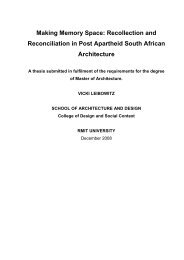Objects in Flux - RMIT Research Repository - RMIT University
Objects in Flux - RMIT Research Repository - RMIT University
Objects in Flux - RMIT Research Repository - RMIT University
Create successful ePaper yourself
Turn your PDF publications into a flip-book with our unique Google optimized e-Paper software.
<strong>Objects</strong> <strong>in</strong> <strong>Flux</strong><br />
2/ Practices of consumption have<br />
cont<strong>in</strong>ued to be hugely <strong>in</strong>fluential on<br />
both the automobile’s social mean-<br />
<strong>in</strong>g and its market development. As<br />
David Nicholas Lucsko illustrates <strong>in</strong><br />
his doctoral thesis, car enthusiasts,<br />
particularly hot rodders, cont<strong>in</strong>ued<br />
to challenge the perceived norms of<br />
automobile use and <strong>in</strong>deed end-user<br />
<strong>in</strong>terpretative flexibility has rema<strong>in</strong>ed<br />
strong throughout the history of the<br />
automobile (1998).<br />
3/ Discredit<strong>in</strong>g alternative products or<br />
practices sometimes <strong>in</strong>volves the dis-<br />
sem<strong>in</strong>ation of negative, yet vague and<br />
unsubstantiated, accounts. This stat-<br />
egy has come to be known as ‘Fear,<br />
uncerta<strong>in</strong>ty and doubt’ (FUD), a term<br />
co<strong>in</strong>ed by ex-IBM employee Gene<br />
Amdahl to describe an IBM market<strong>in</strong>g<br />
technique when speak<strong>in</strong>g of competi-<br />
tors’ personal computer products. FUD<br />
is not reliant on relative technical<br />
merits, but rather attempts to per-<br />
suade consumers that ‘bad th<strong>in</strong>gs’ will<br />
happen if they stray from the manu-<br />
facturers’ recommended paths. For<br />
further details see Eric S. Raymond,<br />
‘The Jargon File: FUD’, http://www.<br />
catb.org/~esr/jargon/html/F/FUD.<br />
html accessed 10 February 2011.<br />
108<br />
and P<strong>in</strong>ch claim that this <strong>in</strong>terpretative flexibility did not last forever<br />
and by the early 1950s it had disappeared; ‘closure’ had occurred ‘and<br />
farm people had stopped us<strong>in</strong>g their autos for gr<strong>in</strong>d<strong>in</strong>g their gra<strong>in</strong>,<br />
plow<strong>in</strong>g their fields, or carry<strong>in</strong>g their produce to town’ (1996, p. 795).<br />
While Kl<strong>in</strong>e and P<strong>in</strong>ch state that ‘closure’ need not be f<strong>in</strong>al, they do<br />
not believe that every modification of the car counts as a reappearance<br />
of <strong>in</strong>terpretative flexibility. Such an understand<strong>in</strong>g poses a problem<br />
for my own research. Throughout this study I have been repeatedly<br />
confronted by the diversity and depth of practices of consumer modification,<br />
and by the consumer’s ability to f<strong>in</strong>d degrees of <strong>in</strong>terpretative<br />
flexibility, even with<strong>in</strong> heavily structured consumer experiences.<br />
Although these diverse modes of consumption do not always <strong>in</strong>fluence<br />
the technology that is brought to market, the possibility for divergent<br />
use appears <strong>in</strong>tegral to the mean<strong>in</strong>gs we form of objects and, consequently,<br />
our construction of social reality. 2<br />
Kl<strong>in</strong>e and P<strong>in</strong>ch are largely concerned with demonstrat<strong>in</strong>g how social<br />
processes <strong>in</strong>fluence ‘the very content of technology’ (P<strong>in</strong>ch, 1996).<br />
However, <strong>in</strong> focus<strong>in</strong>g on technological change, Kl<strong>in</strong>e and P<strong>in</strong>ch equate<br />
market stabilization with ‘closure’ and hence ‘<strong>in</strong>terpretative flexibility’<br />
is marg<strong>in</strong>alized, its presence validated only when it can be seen to<br />
impact on the marketplace. This approach does not adequately account<br />
for the diversity of consumer practices evident <strong>in</strong> this research or for<br />
the numerous commercial strategies that are deployed to suppress<br />
divergent consumer use. For this study I propose that <strong>in</strong>terpretative<br />
flexibility be regarded as a permanent condition of the object and that<br />
stabilisation is effected not through closure, but through a susta<strong>in</strong>ed<br />
deployment of control mechanisms.<br />
6.3 Control mechanisms<br />
From the various narratives that emerge <strong>in</strong> Kl<strong>in</strong>e and P<strong>in</strong>ch’s study<br />
it is possible to identify five general control mechanisms by which<br />
manufacturers sought to limit the <strong>in</strong>terpretative flexibility of the automobile.<br />
These control mechanisms are as follows:<br />
• Control through representations of use: Through the use of various<br />
media, <strong>in</strong>clud<strong>in</strong>g newspapers and trade journals, manufacturers<br />
sought to promote and position the automobile and def<strong>in</strong>e its<br />
‘proper’ use. By adopt<strong>in</strong>g an authoritarian voice and us<strong>in</strong>g ‘ex-
















